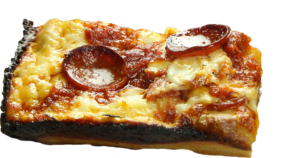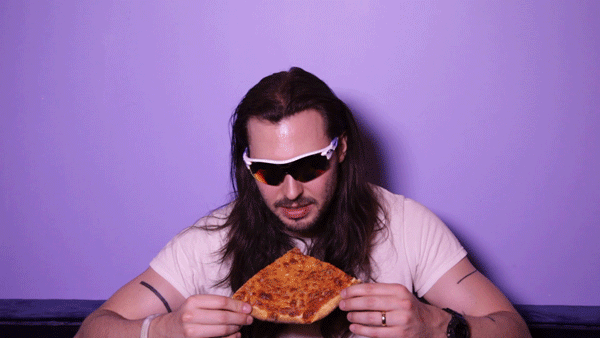It should go without saying to most Riot Fest readers that Andrew W.K. is passionate about a lot of things: the party, music, kindness, the Party Party. However, few things stir his considerable well of passion more than pizza, and on that subject as much as any, Andrew’s approach is radically inclusive and judgment-free. As fellow lovers of all things pizza, but also massive nerds, we went into this interview looking to wed pizza and philosophical/sociological theory, but that quickly fell to the wayside as we were whipped, with Andrew, into a frenzy of pizza-borne enthusiasm. We had to trim the conversation a little, but would be remiss to not include Andrew’s shout-outs to Papa John’s and Domino’s for most improved (“it was very brave to come out and acknowledge ‘hey, we realized it just wasn’t very good'”), Buddy’s in Detroit for inventing the modern Detroit-style pan pizza, and Stouffer’s French Bread pizza (the best frozen option “if you do it the long, hard way in the oven after defrosting in the microwave”).
You love New York City. You’ve said so in song, and you’ve lived there a long time. There’s so much to be said about how New York pizza plays into the philosophy and psychology of the city. The French philosopher Pierre Bourdieu might identify New York pizza as an integral part of the city’s “cultural capital,” and note how the city’s version of pizza is the most widely deferred-to template. Do you think New York pizza’s omnipresence prevents the dominated classes of the rest of the country from defining their own pizza world?
No, not personally. I haven’t noticed New York dominating outside of New York, whether or not it’s because people don’t like that style of pizza, and that’s why it’s not found that commonly outside, or if it’s just impossible to do, which seems somewhat unlikely. Although, yes, I’ve heard these mythical discussions about New York water—which is very good water, tap water in New York is extraordinarily good—and maybe that really is why the crust works the way it does.
It’s an easily-acquired taste, but it’s a very particular take on the idea of pizza. Not everybody wants to hold a jumbo slice. I certainly understand that. If it’s not done properly, even though the crust is very thin, it can also end up being so tough. Outside of New York, those that have attempted to do New York pizza and promote it as such have generally been a failure. I think it’s a curse, almost: if you try to make New York pizza outside of New York, it will fail.
Sure, whether it’s actually a matter of the water, or something spiritual or beyond this world.
A lot of people think that a New York-style slice is just really big, but if the pizza’s no good, the last thing you want is more of it. Even within New York, there are a few different takes. It’s quite popular to have this very sweet tomato sauce, which I don’t enjoy as much. I like the more garlicky sauce, which is not really the typical New York slice.
 The best thing about the New York slice is that it’s thin, without being “thin crust.” There’s just a little crispiness on the very base, that almost cracker-thin crispy shell that breaks up when you fold it slightly, but it’s still very soft within that. The cheese is ideally substantial, but thin enough that you’d never risk pulling off a whole mass of it at once. It’s sort of a “less is more” situation; what makes a New York slice is restraining oneself.
The best thing about the New York slice is that it’s thin, without being “thin crust.” There’s just a little crispiness on the very base, that almost cracker-thin crispy shell that breaks up when you fold it slightly, but it’s still very soft within that. The cheese is ideally substantial, but thin enough that you’d never risk pulling off a whole mass of it at once. It’s sort of a “less is more” situation; what makes a New York slice is restraining oneself.
Do you think that’s why, among New York slice aficionados, the cheese slice is their defining form?
Yes. When I first moved to New York, I’d always get pepperoni slices, because that was my go-to topping in Michigan, but I soon realized that it wasn’t as good as plain cheese. However, I think that’s kind of a chicken/egg thing: they’re selling more cheese pizza, so the cheese pizza’s always fresher. They’re selling less pepperoni, so it’s less fresh and good, and so even less people buy it. It’s a vicious cycle.
You mentioned Michigan. You’re from Ann Arbor. I also spent a long time there, and we both share a good friend in Fred Thomas.
Oh, fantastic, a good omen! I’m not from Michigan originally, but I did grow up there. One of the few non-New York pizza places that claims to a New York slice and actually does it well, NYPD— New York Pizza Depot—is in Ann Arbor. When they opened, I was very skeptical, but it’s very good. I haven’t gone recently, but I was happy to see it was still there last time I was back visiting.
People don’t realize this if they’re not from the area, but Michigan is really the king of the pizza world in a strange way, maybe even a controversial way. I’m sure New York would like to think it is king, as would Chicago, but as far as the prominent pizza chains, Michigan beats them all. Little Caesars, Domino’s, Jet’s, Hungry Howie’s, Cottage Inn…
 Right, and some of those chains do offer their version of the “Detroit-style” pizza, which is of course famously hearty, square, with the cheese all the way to the edges…
Right, and some of those chains do offer their version of the “Detroit-style” pizza, which is of course famously hearty, square, with the cheese all the way to the edges…
Made in repurposed oil pans.
Exactly. One slice eats like a meal, too. Given that it’s so hearty, and decadent without being expensive, you could argue that it’s the ultimate “Pie of the Proletariat.” What do you think of that?
It’s definitely coming from a working-class approach, but that might not have occurred to me. Chicago also has “tavern-style” pizza, and New York has a parallel tradition of “grandma” pizza. A lot of young people have also had different experiences with homemade pizza: maybe their mom would make pizza on pita bread, or there would be pizza on English muffins or bagels. We’re not even getting into all the frozen/pre-made varieties. I think Detroit-style gets into the same spirit: I want to make pizza myself, but if I go to a restaurant, I want that feeling that I could have made it myself. There’s something humble, or at least straightforward, about it. It’s not meant to be a mystery. Just the size of the oven required to make a New York-style pie puts it beyond the reach (of the common man).
Now, what happened in LA, in California, also comes off that “homemade pizza” concept. Beyond even what’s identified as “California style,” there’s a rich tradition of places like Barone’s, who also do a rectangular style that’s fantastic. I don’t know the story, but I wouldn’t be surprised if they came out of the same traditions which determined the dominant pizza style in the midwest. Either way, that style is all part of the “homemade” philosophy. Like, if you’re making pizza at home, maybe you’d put some leftover BBQ chicken on it, or a salad, or eggs, or whatever other kooky thing you had.
That’s such a major part of the dominant “California style,” too, and its Pacific Northwest mutant variant. Someone might put duck sausage on pizza, artichoke hearts are extremely common… where I live, in Portland, you can’t shake a stick without hitting an artichoke heart pizza.
I love all these varieties and approaches, and I also love the passion that goes into defending and promoting them. It can get a little extreme, like sports: if I were to wear a hat or something for some team, I might get someone coming up to me telling me that they used to like my music, but now they’ll never party with me again, and that thing happens with pizza, too. If you can embrace it as a friendly competition, I enjoy it, but if the goal is to eliminate other kinds of pizza, that’s lose-lose for everybody. The more passion, the more variety, the more competition, ultimately helps pizza all over.
A rising pizza tide lifts all pizza boats.
 Exactly. Though we’re talking about U.S. styles, by the way, I’d like to do an honorable mention to Canada. I’ve toured quite extensively throughout Canada, and there’s no other place I’ve been where even the smallest rural towns have pizza delivery places which are open until 5 or 6am. In a lot of big cities, even, you might not have any food options that late, but in Canada there will be a pizza place open late, and it will be extremely good! I thought it was just a fluke at first, but it’s throughout the country, a secret Canadian tradition.
Exactly. Though we’re talking about U.S. styles, by the way, I’d like to do an honorable mention to Canada. I’ve toured quite extensively throughout Canada, and there’s no other place I’ve been where even the smallest rural towns have pizza delivery places which are open until 5 or 6am. In a lot of big cities, even, you might not have any food options that late, but in Canada there will be a pizza place open late, and it will be extremely good! I thought it was just a fluke at first, but it’s throughout the country, a secret Canadian tradition.
Well, the secret’s out now.
I don’t believe they get enough praise for both the quality and convenience. It’s probably because Canadians are quite robust, and many of them like to stay up late, and many also like drinking alcohol. That all works very well for pizza places.
It’s a match made in heaven.
It really is. It’s an almost euphoric experience to be very hungry, possibly inebriated, and then to have pizza.
This is probably impossible to answer, but do you and your tour crew have a favorite pizza stop?
Not really, no, but I’m in Los Angeles right now and I’m frustrated, because my schedule does not permit my going to Barone’s. I went just a few weeks ago, and even with all my excitement about going, it exceeded my highest expectations. I ate an entire pizza by myself. It was one of those perfect experiences where, as it’s happening, I realized “this is IT”: this is what all that work, all the bad experiences were working towards. Noticing that as it’s happening is jarring; it’s not like thinking back to it a week later and thinking “oh yeah, that really was good.” In the midst of it, time stopped. The past and the future all coalesced, I was fully in the present moment because this pizza was so good. I couldn’t think about the past or the future; all I could think about was biting into that slice.
I’m laughing, but I’m earnest when I say that that is beautiful.
I’m sure you were going to bring it up, but we have to talk about Chicago pizza. It’s pretty important.
It’s very important, but also divisive: a lot of people in New York and Detroit refer to Chicago deep dish as “pizza casserole.” It’s generally considered too heavy for California pizza fans. It all sort of seems to play into Chicago’s “Second City” designation. Do you think that Chicago picked a pizza style which doomed them to divisive status?
I have a lot of thoughts about this. First of all, there’s more than one style of Chicago pizza, the “stuffed pizza” just being the most radical. It takes the front page because it’s so different from anything else. However, Chicago has other legitimate pizza styles, like the traditional round with thinner crust cut into squares, which I think is fantastic. I think it easily rivals New York slices. It’s cut different, the sauce is different, but it’s really unsung because it’s not as conceptually extreme as the deep dish. If I were going to a Chicago pizza place, though, that’s what I’d prefer to get.
When it comes to deep dish, though: yes, it’s an undertaking, like going out for any other kind of (heavy Italian food)… but the idea that you can make a blanket judgment, when all the varieties are so different, is absurd. What you get at Pizza Uno versus what you’d get at, say, Giordano’s, is almost night and day.
Right. To write the concept off wholesale, based on limited experience, is perhaps unfair.
You have to, at the very least, have a stuffed pizza from Uno, Giordano’s, and Lou Malnati’s to be able to even have a starting point. Each tastes radically different. I’m not going to say which I prefer, because I like them all for different reasons.
Then, there are so many great “tavern-style” places: Home Run Inn, Roundhead’s, and on and on. I think people would be really delighted, if they explored, to see this whole other side to Chicago pizza that is just as much its own thing.
Here’s the thing: there comes a point with things that you love where you can just settle on the fact that you love it, and you love it on its own terms: its ups and downs, pros and cons, wins and losses, best and worst. It’s just like a marriage. You’re really cheating yourself to take any more of a critical view after that. You can love humanity, and of course that doesn’t mean that you want to hang out and be close friends with every single person. You couldn’t if you wanted!
It’s sad to think, but you also can’t eat every single pizza that’s available in the world, even if you made it your life’s mission. But pizza is like music: you love the phenomenon and all that comes with it. It pains me to see people to incorporate resentment or animosity into something that should just be pure pleasure. Pizza is joy.




